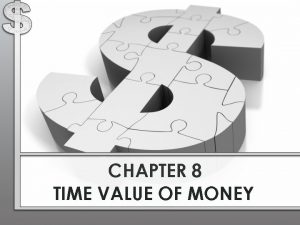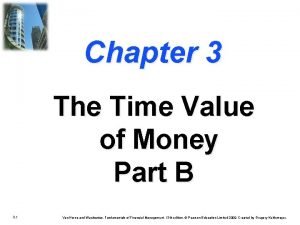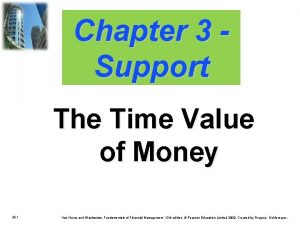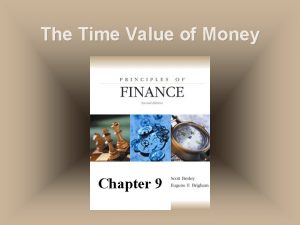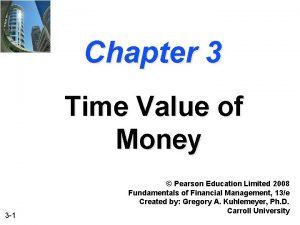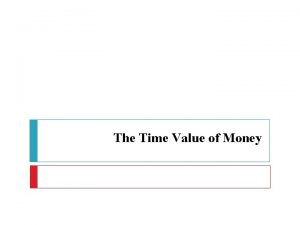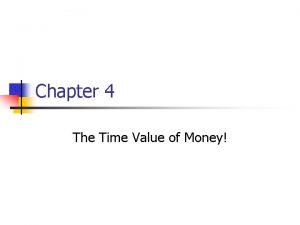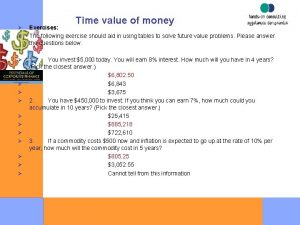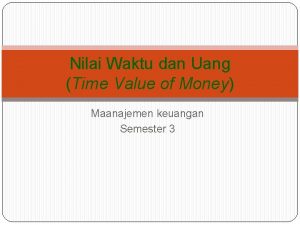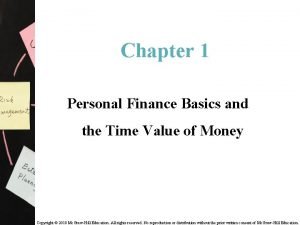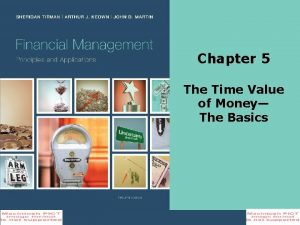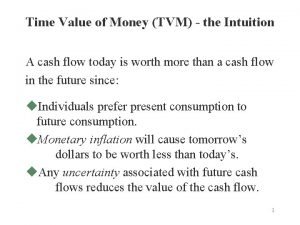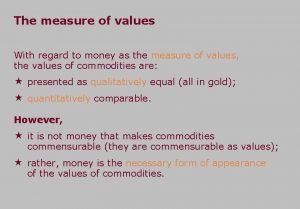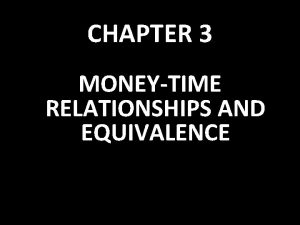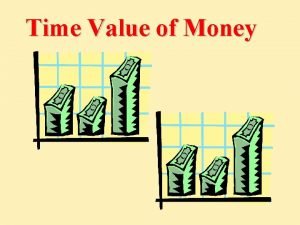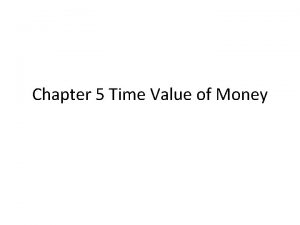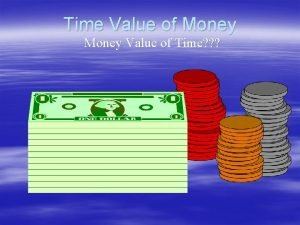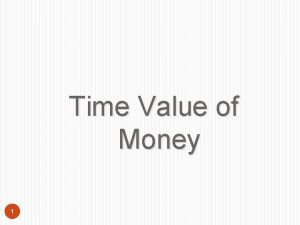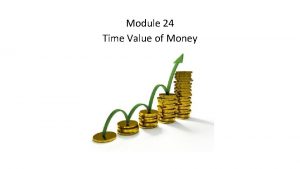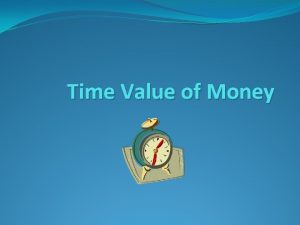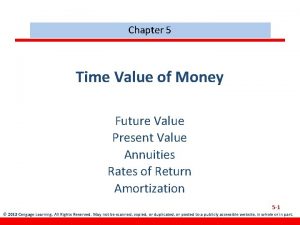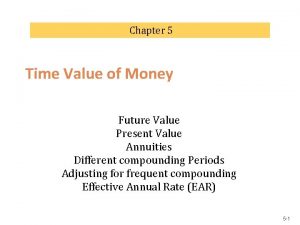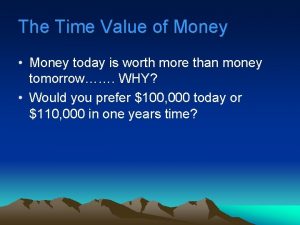Chapter 6 Time Value of Money Part II




































- Slides: 36

Chapter 6 Time Value of Money (Part II) Updated 2 -2015

Ordinary Annuities • Annuity – A series of equal cash flows that are made at an fixed interval (i. e. monthly, quarterly, or annually etc. ) over a certain period of time. • If payments are made at the end of each period, the annuity is referred to as ordinary (regular) annuity. – Ex. 1: • How much money will you have by the end of year 5 if you deposit $5, 000 at the end of each year for five years in a savings account that earns 6% per year? Copyright © 2014 Pearson Education, Inc. All rights reserved. 6 -2

Future Value of an Ordinary Annuity (1 c) • FVn = FV of annuity at the end of nth period. • PMT = Annuity payment deposited or received at the end of each period • i = Interest rate period • n = Number of periods for which annuity will last Copyright © 2014 Pearson Education, Inc. All rights reserved. 6 -3

Future Value of an Ordinary Annuity (cont. ) • FV = $5000 {[ (1+. 06)5 - 1] ÷ (. 06)} = $5, 000 {5. 6371} = $28, 185. 50 • Using a Financial Calculator Enter • N =5 • 1/y = 6. 0 • PV =0 • PMT = -5000 • FV = $28, 185. 46 Copyright © 2014 Pearson Education, Inc. All rights reserved. • Using an Excel Spreadsheet FV of Annuity = FV(rate, nper, pmt, pv) = FV(. 06, 5, -5000, 0) = $ 28, 185. 46 6 -4

Checkpoint 1 Solving for an Ordinary Annuity Payment (PMT) How much must you deposit each year in a savings account earning 8% annual interest in order to have $5, 000 at the end of year 10? (1 c) Copyright © 2014 Pearson Education, Inc. All rights reserved. 6 -5

Checkpoint 1 (1 c) Copyright © 2014 Pearson Education, Inc. All rights reserved. 6 -6

Solving for Interest Rate in an Ordinary Annuity • In 15 years, you hope to have $30, 000 saved to buy a sports car. If you are able to save $1, 022 at the end of each year for the next 15 years, what rate of return must you earn on your investments in order to achieve your goal? Copyright © 2014 Pearson Education, Inc. All rights reserved. 6 -7

Solving for Interest Rate in an Ordinary Annuity (cont. ) • Using Mathematical Formula (1 c) $30, 000 = $1, 022{[ (1+i)15 - 1] ÷ (i)}] 29. 354 = {[ (1+i)15 - 1] ÷ (i)} • The only way to solve for “i” mathematically is by trial and error. • We will have to substitute different numbers for i until we find the value of i that makes the right hand side of the expression equal to 29. 354. Copyright © 2014 Pearson Education, Inc. All rights reserved. 6 -8

Solving for Interest Rate in an Ordinary Annuity (cont. ) • Using a Financial Calculator Enter • N = 15 • PMT = -$1, 022 • FV = $30, 000 • PV = $0 • i = 9. 00 Copyright © 2014 Pearson Education, Inc. All rights reserved. • Using an Excel Spreadsheet i = Rate (nper, PMT, pv, fv) = Rate (15, -1022, 0, 30000) = 9. 00% 6 -9

Solving for Number of Periods in an Ordinary Annuity • Suppose you are investing $5, 000 at the end of each year in an account that pays 7%. • How long will it take before the account is worth $51, 300? • Using a Financial Calculator • Using an Excel Spreadsheet Enter n = NPER(rate, pmt, pv, fv) • I/y = 7. 0 n = NPER(7%, -5000, 0, 51300) • PV =0 n = 8 years • PMT = -5, 000 • FV = 51, 300 • N =8 Copyright © 2014 Pearson Education, Inc. All rights reserved. 6 -10

Present Value of an Ordinary Annuity (2 b) • PMT = Annuity payment deposited or received at the end of each period. • i = Discount rate (or interest rate) on a period basis. • n = Number of periods for which the annuity will last. • Note: it is important that “n” and “i” match. – If periods are expressed in terms of number of monthly payments, the interest rate must be expressed in terms of the interest rate per month. Copyright © 2014 Pearson Education, Inc. All rights reserved. 6 -11

Checkpoint 2 Present Value of an Ordinary Annuity • Your grandmother has offered to give you $1, 000 per year for next 10 years. • What is the present value of this 10 -year, $1, 000 annuity discounted back to the present at 5 percent? (2 b) Copyright © 2014 Pearson Education, Inc. All rights reserved. 6 -12

Checkpoint 2 (2 b) Copyright © 2014 Pearson Education, Inc. All rights reserved. 6 -13

Amortized Loans • An amortized loan is a loan that will be paid off in equal payments, thus, the loan payments are an annuity. – Ex. : Home mortgage loans, Auto loans • In an amortized loan: – – Present value is the n is total number of i is the interest rate Future value is zero periods – Payment is the loan amount borrowed periods the loan lasts for period because the loan will be paid off after n payment that is made period Copyright © 2014 Pearson Education, Inc. All rights reserved. 6 -14

Amortized Loans (cont. ) • Suppose you plan to get a $6, 000 car loan at 15% annual interest with annual payments that you will pay off over four years. • What will your annual payments be on this loan? • Using a Financial Calculator Enter • N =4 • i/y = 15. 0 • PV = 6, 000 • FV =0 • PMT = -$2, 101. 59 Copyright © 2014 Pearson Education, Inc. All rights reserved. 6 -15

Loan Amortization Schedule Year Amount Owed on Principal at the Beginning of the Year Annuity Payment Interest Portion of the Annuity Repayment of the Principal Portion of the Annuity (1) (2) (3)= (1)× 15% (4) = (2)–(3) Outstanding Loan Balance at Year end, After the Annuity Payment (5)= (1)–(4) 1 $6, 000 $2, 101. 59 $900. 00 $1, 201. 59 $4, 798. 41 2 $4, 798. 41 $2, 101. 59 $719. 76 $1, 381. 83 $3, 416. 58 $2, 101. 59 $512. 49 $1, 589. 10 $1, 827. 48 4 $1, 827. 48 $2, 101. 59 $274. 12 $1, 827. 48 $0. 00 • Size of each payment remains the same. • But, interest payment declines each year as the amount owed declines and more of the principal is repaid. • No lump sum payment of principal at the end Copyright © 2014 Pearson Education, Inc. All rights reserved. 6 -16

Annuities (Ordinary Annuity vs. Annuity Due) • Time lines End of period Beginning of period Copyright © 2014 Pearson Education, Inc. All rights reserved. 6 -17

Annuities (Ordinary Annuity vs. Annuity Due) End of period Future Value FVA 3 = 100(FVIFA 5%, 3) Beginning of period FVA 3 Due = 100(FVIFA 5%, 3)(1+5%) Copyright © 2014 Pearson Education, Inc. All rights reserved. 6 -18

Annuities Due • Annuity due is an annuity in which all cash flows occur at the beginning of the period. – Ex. : Rent payments on apartments are typically annuity due as rent is paid at the beginning of the month. • Computation of future value of an annuity due requires compounding the cash flows for one additional period, beyond an ordinary annuity. (3) Copyright © 2014 Pearson Education, Inc. All rights reserved. 6 -19

Annuities Due: Future Value • Recall Ex. 1 where we calculated future value of 5 -year ordinary annuity of $5, 000 earning 6 percent to be $28, 185. 46. • What will be the future value if deposits of $5, 000 were made at the beginning of the year (cash flows were annuity due)? • FV = $5000 {[ (1+. 06)5 - 1] ÷ (. 06)}*(1. 06) = $28, 185. 46 (1. 06) = $29, 876. 59 Copyright © 2014 Pearson Education, Inc. All rights reserved. 6 -20

Annuities (Ordinary Annuity vs. Annuity Due) End of period Present Value PVA = 100(PVIFA 5%, 3) Beginning of period PVA Due = 100(PVIFA 5%, 3)(1+5%) Copyright © 2014 Pearson Education, Inc. All rights reserved. 6 -21

Annuities Due: Present Value • Since with annuity due, each cash flow is received one year earlier, its present value will be discounted back for one less period. (4) Copyright © 2014 Pearson Education, Inc. All rights reserved. 6 -22

Annuities Due: Present Value (cont. ) • Recall checkpoint 2: Check yourself problem where we computed PV of 10 -year ordinary annuity of $1, 000 at a 5 percent discount rate to be equal to $7, 721. 73. • What will be the present value if $1, 000 is received at the beginning of each year (cash flows were annuity due)? • PV = = $1, 000 {[1 -(1/(1. 05)10] ÷ (. 05)}*(1. 05) $1, 000 {[ 0. 3861] ÷ (. 05)}*(1. 05) $1, 000 (7. 7217) (1. 05) $ 8, 107. 82 Copyright © 2014 Pearson Education, Inc. All rights reserved. 6 -23

Annuities Due • The examples show that both future value & present value of an annuity due are larger than that of an ordinary annuity because, in each case, all payments are received or paid earlier. Copyright © 2014 Pearson Education, Inc. All rights reserved. 6 -24

Perpetuities • A perpetuity is a series of cash flow that continues forever or has no maturity. • Two basic types of perpetuities: – Level perpetuity in which the payments are constant from period to period. • Ex: a dividend stream on a share of preferred stock. – Growing perpetuity in which cash flows grow at a constant rate (g) from period to period. • Ex: a dividend stream on a share of common stock. Copyright © 2014 Pearson Education, Inc. All rights reserved. 6 -25

Present Value of a Level Perpetuity (5) • PV = PV of a level perpetuity • PMT = Constant dollar amount provided by the perpetuity • i = Interest (or discount) rate period Copyright © 2014 Pearson Education, Inc. All rights reserved. 6 -26

Checkpoint 4 Present Value of a Level Perpetuity What is the present value of a perpetuity of $500 paid annually discounted back to the present at 8 percent? (5) Copyright © 2014 Pearson Education, Inc. All rights reserved. 6 -27

Checkpoint 4 (5) Copyright © 2014 Pearson Education, Inc. All rights reserved. 6 -28

Present Value of a Growing Perpetuity • In growing perpetuities, the periodic cash flows grow at a constant rate each period. • Present value of a growing perpetuity can be calculated by: (6) • PV • PMTperiod • i • g 1 = Present value of a growing perpetuity = Payment made at end of the first period = Interest rate used to discount the growing perpetuity’s cash flows = Rate of growth in the payment of cash flows from period to period Copyright © 2014 Pearson Education, Inc. All rights reserved. 6 -29

Checkpoint 5 Present Value of a Growing Perpetuity • What is the present value of a perpetuity stream of cash flows that pays $500 at end of year one but grows at a rate of 4% per year indefinitely? • Rate of interest used to discount the cash flows is 8%. (6) Copyright © 2014 Pearson Education, Inc. All rights reserved. 6 -30

Checkpoint 5 (6) (4) Copyright © 2014 Pearson Education, Inc. All rights reserved. 6 -31

Personal Summary • Write down one thing you learned in this chapter that is interesting, new, or useful to you. • ___________________________________ Copyright © 2014 Pearson Education, Inc. All rights reserved. 6 -32

Exercise (End of Ch. ) Question 30 – Determine the present value of an annuity due of $1, 000 per year for 10 years discounted back to the present at an annual rate of 10 percent. – What would be the present value of this annuity due if it were discounted at an annual rate of 15 percent? Copyright © 2014 Pearson Education, Inc. All rights reserved. 6 -33

Exercise (End of Ch. ) Question 24 • You are trying to plan for retirement in 10 years and currently you have $150, 000 in a savings account and $250, 000 in stocks. In addition, you plan to add to your savings by depositing $8, 000 per year in your savings account at the end of each of the next five years and then $10, 000 per year at the end of each year for the final five years until retirement. – (a) Assuming your savings account returns 8 percent compounded annually and your investment in stocks will return 12 percent compounded annually, how much will you have at the end of 10 years? – (b) If you expect to live for 20 years after you retire, and at retirement you deposit all of your savings in a bank account paying 11 percent, how much can you withdraw each year after retirement (20 equal withdrawals beginning one year after your retire) to end up with a zero balance at death? Copyright © 2014 Pearson Education, Inc. All rights reserved. 6 -34

Exercise (End of Ch. ) Question 56 Copyright © 2014 Pearson Education, Inc. All rights reserved. 6 -35

Exercise Copyright © 2014 Pearson Education, Inc. All rights reserved. 6 -36
 Dana damian
Dana damian Chapter 8 time value of money answer key
Chapter 8 time value of money answer key Firmilate
Firmilate Chapter 3 time value of money problem solutions
Chapter 3 time value of money problem solutions Chapter 2 time value of money solutions
Chapter 2 time value of money solutions Chapter 3 time value of money problem solutions
Chapter 3 time value of money problem solutions Time value of money contoh soal
Time value of money contoh soal Objective of time value of money
Objective of time value of money Introduction to valuation the time value of money
Introduction to valuation the time value of money Time value of money quiz
Time value of money quiz Time value of money exercise
Time value of money exercise Faktor yang mempengaruhi time value of money
Faktor yang mempengaruhi time value of money Diskusi tentang time value of money
Diskusi tentang time value of money Personal finance basics and the time value of money
Personal finance basics and the time value of money Time value of money
Time value of money Time value of money
Time value of money Pengertian time value of money
Pengertian time value of money Apa itu value creation
Apa itu value creation Site:slidetodoc.com
Site:slidetodoc.com Money smart money match
Money smart money match Money on money multiple
Money on money multiple The great gatsby historical background
The great gatsby historical background Tom buchanan character traits
Tom buchanan character traits Start time end time and elapsed time
Start time end time and elapsed time How to write centavos
How to write centavos Value of money meaning
Value of money meaning How to calculate future value of money
How to calculate future value of money Present and future value of money
Present and future value of money Internal value of money
Internal value of money Assessing value for money
Assessing value for money Money as a measure of value
Money as a measure of value Nilai waktu dari uang
Nilai waktu dari uang Money-time relationship and equivalence
Money-time relationship and equivalence With money you can buy clock but not time
With money you can buy clock but not time You can buy a clock but not time
You can buy a clock but not time Money-time relationship and equivalence
Money-time relationship and equivalence How time and interest affect money
How time and interest affect money

